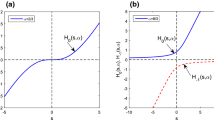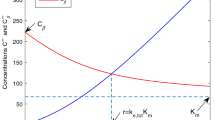Abstract
Indirect response models require differential equations to describe the nonlinear inhibition or stimulation of the production or loss (kout ) of the response variable. Partially integrated solutions for these models developed previously for iv bolus or biphasic pharmacokinetics were extended to consider drug infusions for limited or extended durations. Qualitative examination was made of the role of infusion rate and duration, type and rate of drug disposition, Imax or Smax capacity factors, IC50 or SC50 sensitivity factors, and kout values. Properties of the response curves characterized include curve shapes, maximum or minimum response, onset rate, steady-state, and return to baseline. Some comparisons were made with behavior of iv bolus doses. These relationships provide both a formal and practical basis for better understanding of the time-course of basic indirect response models.
Similar content being viewed by others
REFERENCES
N. L. Dayneka, V. Garg, and W. J. Jusko. Comparison of four basic models of indirect pharmacodynamic responses. J. Pharmacokin. Biopharm. 21:457–478 (1993).
W. J. Jusko and H. C. Ko. Physiologic indirect response models characterize diverse types of pharmacodynamic effects. Clin. Pharmacol. Ther. 56:406–419 (1994).
A. Sharma and W. J. Jusko. Characterization of four basic models of indirect pharmacodynamic responses. J. Pharmacokin. Biopharm. 24:611–635 (1996).
W. Krzyzanski and W. J. Jusko. Mathematical formalism for the properties of four basic models of indirect pharmacodynamic responses. J. Pharmacokin. Biopharm. 25:107–123 (1997).
L. B. Sheiner, D. R. Stanski, S. Vozeh, R. D. Miller, and J. Ham. Simultaneous modeling of pharmacokinetics and pharmacodynamics: Application to d-turbocurarine. Clin. Pharmacol. Ther. 25:358–371 (1979).
J. Gabrielsson and D. Weiner. Pharmacokinetic/Pharmacodynamic Data Analysis: Concepts and Applications, 2nd ed., Swedish Pharmaceutical Press, Stockholm, 1997.
F. W. J. Olver. Asymptotics and Special Functions. Academic Press, New York, 1974.
Author information
Authors and Affiliations
Rights and permissions
About this article
Cite this article
Krzyzanski, W., Jusko, W.J. Mathematical Formalism and Characteristics of Four Basic Models of Indirect Pharmacodynamic Responses for Drug Infusions. J Pharmacokinet Pharmacodyn 26, 385–408 (1998). https://doi.org/10.1023/A:1021060000789
Published:
Issue Date:
DOI: https://doi.org/10.1023/A:1021060000789




